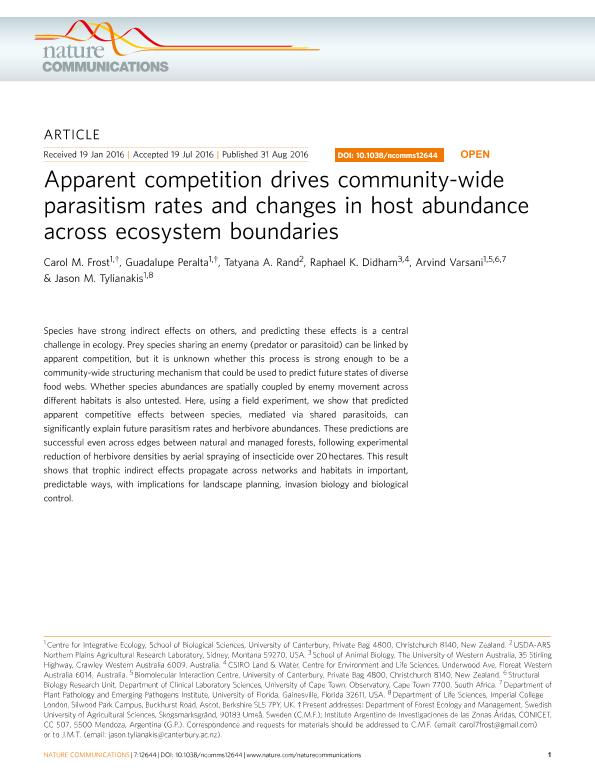Mostrar el registro sencillo del ítem
dc.contributor.author
Frost, Carol M.
dc.contributor.author
Peralta, Guadalupe

dc.contributor.author
Rand, Tatyana A.
dc.contributor.author
Didham, Rapahel K.
dc.contributor.author
Varsani, Ardvin
dc.contributor.author
Tylianakis Jason M.
dc.date.available
2018-05-10T21:13:19Z
dc.date.issued
2016-07
dc.identifier.citation
Frost, Carol M.; Peralta, Guadalupe; Rand, Tatyana A.; Didham, Rapahel K.; Varsani, Ardvin; et al.; Apparent competition drives community-wide parasitism rates and changes in host abundance across ecosystem boundaries; Nature Publishing Group; Nature Communications; 7; 12644; 7-2016; 1-12
dc.identifier.issn
2041-1723
dc.identifier.uri
http://hdl.handle.net/11336/44836
dc.description.abstract
Species have strong indirect effects on others, and predicting these effects is a central challenge in ecology. Prey species sharing an enemy (predator or parasitoid) can be linked by apparent competition, but it is unknown whether this process is strong enough to be a community-wide structuring mechanism that could be used to predict future states of diverse food webs. Whether species abundances are spatially coupled by enemy movement across different habitats is also untested. Here, using a field experiment, we show that predicted apparent competitive effects between species, mediated via shared parasitoids, can significantly explain future parasitism rates and herbivore abundances. These predictions are successful even across edges between natural and managed forests, following experimental reduction of herbivore densities by aerial spraying of insecticide over 20 hectares. This result shows that trophic indirect effects propagate across networks and habitats in important, predictable ways, with implications for landscape planning, invasion biology and biological control.
dc.format
application/pdf
dc.language.iso
eng
dc.publisher
Nature Publishing Group

dc.rights
info:eu-repo/semantics/openAccess
dc.rights.uri
https://creativecommons.org/licenses/by/2.5/ar/
dc.subject
Apparent Competition
dc.subject
Parasitoid
dc.subject
Herbivore
dc.subject.classification
Otras Ciencias Biológicas

dc.subject.classification
Ciencias Biológicas

dc.subject.classification
CIENCIAS NATURALES Y EXACTAS

dc.title
Apparent competition drives community-wide parasitism rates and changes in host abundance across ecosystem boundaries
dc.type
info:eu-repo/semantics/article
dc.type
info:ar-repo/semantics/artículo
dc.type
info:eu-repo/semantics/publishedVersion
dc.date.updated
2018-04-18T14:52:30Z
dc.journal.volume
7
dc.journal.number
12644
dc.journal.pagination
1-12
dc.journal.pais
Reino Unido

dc.journal.ciudad
Londres
dc.description.fil
Fil: Frost, Carol M.. University Of Canterbury; Nueva Zelanda. Swedish University Of Agricultural Sciences; Suecia
dc.description.fil
Fil: Peralta, Guadalupe. Consejo Nacional de Investigaciones Científicas y Técnicas. Centro Científico Tecnológico Conicet - Mendoza. Instituto Argentino de Investigaciones de las Zonas Áridas. Provincia de Mendoza. Instituto Argentino de Investigaciones de las Zonas Áridas. Universidad Nacional de Cuyo. Instituto Argentino de Investigaciones de las Zonas Áridas; Argentina. University Of Canterbury; Nueva Zelanda
dc.description.fil
Fil: Rand, Tatyana A.. Usda Northern Plains Agricultural Research Laboratory; Estados Unidos
dc.description.fil
Fil: Didham, Rapahel K.. University of Western Australia; Australia
dc.description.fil
Fil: Varsani, Ardvin. University Of Canterbury; Nueva Zelanda. University of Florida; Estados Unidos
dc.description.fil
Fil: Tylianakis Jason M.. University Of Canterbury; Nueva Zelanda. Imperial College London; Reino Unido
dc.journal.title
Nature Communications

dc.relation.alternativeid
info:eu-repo/semantics/altIdentifier/doi/http://dx.doi.org/10.1038/ncomms12644
dc.relation.alternativeid
info:eu-repo/semantics/altIdentifier/url/https://www.nature.com/articles/ncomms12644
Archivos asociados
